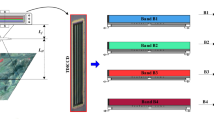6 Conclusion
When using 3-D wavelet transforms for hyperspectral image compression, systematic variations in signal level of different spectral bands can cause widely-varying mean values in spatial planes of spatially low-pass subbands. Failing to account for this phenomenon can have detrimental effects on image compression, including reduced effectiveness in compressing spatially low-pass subband data, and biases in some reconstructed spectral bands.
These effects can be mitigated by subtracting the mean value from each spatial plane of each spatially low-pass subband, or by modifying the wavelet decomposition to perform extra stages of spatial decomposition in spatially low-pass subbands, or by a combination of these approaches. We presented examples illustrating that these methods offer similar improvements in rate-distortion performance. Both approaches reduce biases in reconstructed spectral bands and provide an improvement in subjective reconstructed image quality. The modified decomposition has the advantage that it does not have a tendency to produce visible boundaries between error-containment segments.
Access this chapter
Tax calculation will be finalised at checkout
Purchases are for personal use only
Preview
Unable to display preview. Download preview PDF.
Similar content being viewed by others
References
A. Kiely and M. Klimesh, “The ICER progressive wavelet image compressor,” The Interplanetary Network Progress Report 42-155, vol. July–September 2003, pp. 1–46, November 15, 2003, Jet Propulsion Laboratory, Pasadena, California. http://ipnpr.jpl.nasa.gov/tmo/progress_report/42-155/155J.pdf.
—, “Preliminary image compression results from the Mars Exploration Rovers,” The Interplanetary Network Progress Report, vol. 42–156, pp. 1–8, February 15, 2004, Jet Propulsion Laboratory, Pasadena, California. http://ipnpr.jpl.nasa.gov/tmo/progress_report/42-156/156I.pdf.
X. Tang, S. Cho, and W. A. Pearlman, “3D set partitioning coding methods in hyperspectral image compression,” in Proc. 2003 International Conference on Image Processing, vol. II, 14–17 Sept. 2003, pp. II-239–II-242.
Y. Wang, J. T. Rucker, and J. E. Fowler, “Three-dimensional tarp coding for the compression of hyperspectral images,” IEEE Geoscience and Remote Sensing Letters, vol. 1, no. 2, pp. 136–140, April 2004.
S. Lim, K. Sohn, and C. Lee, “Compression for hyperspectral images using three dimensional wavelet transform,” in Proc. IEEE 2001 International Geoscience and Remote Sensing Symposium (IGARSS’ 01), vol. 1, 2001, pp. 109–111.
G. Vane, R. Green, T. Chrien, H. Enmark, E. Hansen, and W. Porter, “The Airborne Visible/Infrared Imaging Spectrometer (AVIRIS),” Remote Sensing of Environment, vol. 44, pp. 127–143, 1993.
M. D. Adams and F. Kossentini, “Reversible integer-to-integer wavelet transforms for image compression: Performance evaluation and analysis,” IEEE Transactions on Image Processing, vol. 9, no. 7, pp. 1010–1024, June 2000.
A. Said and W. Pearlman, “An image multiresolution representation for lossless and lossy compression,” IEEE Transactions on Image Processing, vol. 9, no. 5, pp. 1303–1310, September 1996.
S. G. Mallat, “A theory for multiresolution signal decomposition: The wavelet representation,” IEEE Transactions on Pattern Analysis and Machine Intelligence, vol. 11, no. 7, pp. 674–693, July 1989.
D. S. Taubman and M. W. Marcellin, JPEG2000: Image Compression Fundamentals, Standards and Practice. Boston, MA: Kluwer Academic Publishers, 2002.
A. Kiely, “Progressive transmission and compression of images,” TDA Progress Report 42-124, vol. October–December 1995, pp. 88–103, February 15 1995, jet Propulsion Laboratory, Pasadena, California. http://tmo.jpl.nasa.gov/tmo/progress._report/42-124/124E.pdf.
J. M. Shapiro, “Embedded image coding using zerotrees of wavelet coefficients,” IEEE Transactions on Signal Processing, vol. 41, no. 12, pp. 3445–3462, December 1993.
A. Said and W. Pearlman, “A new, fast, and efficient image codec based on set partitioning in hierarchical trees,” IEEE Transactions on Circuits and Systems for Video Technology, vol. 6, no. 3, pp. 243–250, June 1993.
D. Taubman, “High performance scalable image compression with EBCOT,” IEEE Transactions on Image Processing, vol. 9, no. 7, pp. 1158–1170, July 2000.
Z. Xiong, X. Wu, S. Cheng, and J. Hua, “Lossy-to-lossless compression of medical volumetric data using three-dimensional integer wavelet transforms,” IEEE Transactions on Medical Imaging, vol. 22, no. 3, pp. 459–470, March 2003.
B.-J. Kim, Z. Xiong, and W. A. Pearlman, “Low bit-rate scalable video coding with 3-D set partitioning in hierarchical trees (3-D SPIHT),” IEEE Transactions on Circuits and Systems for Video Technology, vol. 10, no. 8, pp. 1374–1387, December 2000.
J. Y. Tham, S. Ranganath, and A. A. Kassim, “Highly scalable wavelet-based video codec for very low bit-rate environment,” IEEE Journal on Selected Areas in Communications, vol. 16, no. 1, pp. 12–27, January 1998.
Author information
Authors and Affiliations
Editor information
Editors and Affiliations
Rights and permissions
Copyright information
© 2006 Springer Science+Business Media, Inc.
About this chapter
Cite this chapter
Klimesh, M., Kiely, A., Xie, H., Aranki, N. (2006). Spectral Ringing Artifacts in Hyperspectral Image Data Compression. In: Motta, G., Rizzo, F., Storer, J.A. (eds) Hyperspectral Data Compression. Springer, Boston, MA. https://doi.org/10.1007/0-387-28600-4_13
Download citation
DOI: https://doi.org/10.1007/0-387-28600-4_13
Publisher Name: Springer, Boston, MA
Print ISBN: 978-0-387-28579-5
Online ISBN: 978-0-387-28600-6
eBook Packages: Computer ScienceComputer Science (R0)




